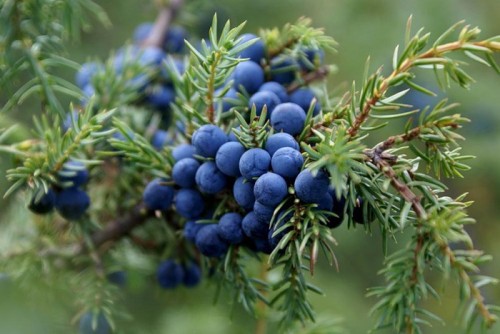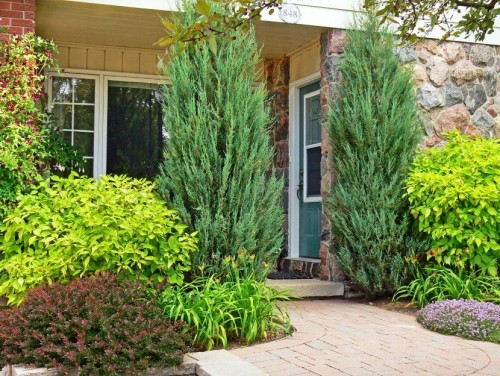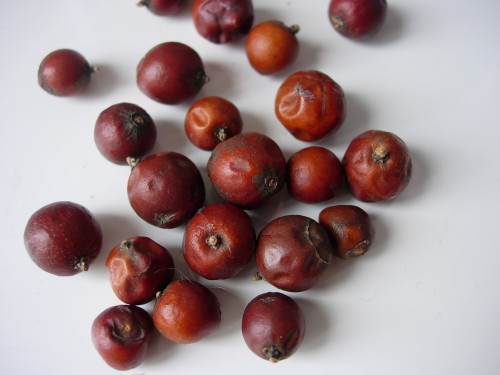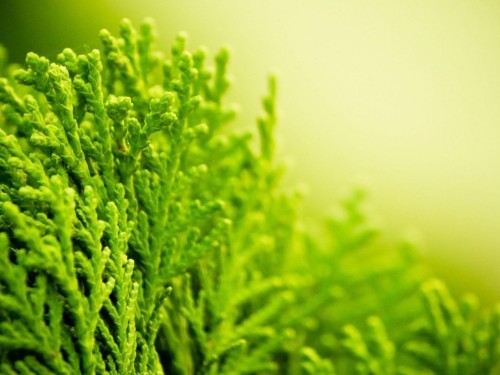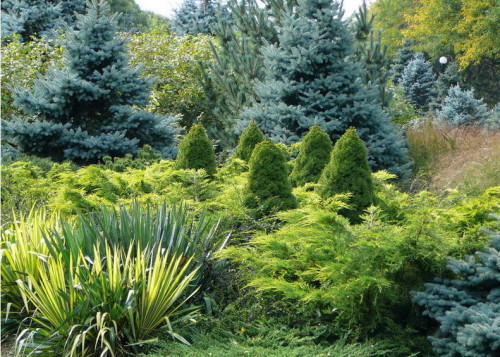Juniper is a very beautiful perennial plant that perfectly fit into the landscape garden design. Green spreader branches do not lose their attractiveness even in the cold winter months, so a fluffy shrub will decorate a floweruba even when everything around will flash. Among other things, the juniper has therapeutic properties. If you decide to plant a plant on your land plot, our article will tell you the main subtleties of growing and reproducing this culture.
Content
Features of the seedlovens of juniper
In the northern regions with a cold climate, the juniper feels most comfortable. Therefore, if you had a chance to live in such a locality, you can easily find suitable plant saplings in the near forest. Well, if you do not have the opportunity to dig anywhere anywhere, do not be mistaken, because juniper saplings can be purchased on the market. So that your plant is good and did not dare, it is very important to choose the right selection material. Consider several subtleties to choose seedlings:
- The age of sprouts should be at least 3 years.
- When buying, pay attention to those seedlings that are sold along with a lump of land from which they were dug.
- Make sure the roots of the plant were not open.
- Purchase sprouts immediately before boarding, which is best done in the second half of spring.
If you decide to dig up the landing material yourself, listen to the following tips:
- Search for juniper seedlings follows coniferous or mixed forests. Shrubs are often growing in small groups. You need to choose a sprout where they grow quite a lot on a small area.
- So that the culture has taken root on the plot, pick a healthy planting material. Carefully inspect the needles and branches - they should be green, smooth and not dried.
- Please note how bush grows relative to the parties of the world. Remember its location, so that it is later to plant it on its plot in the same way.
- Digging the seedling, retreat approximately 0.5 m from the barrel, carefully cut the soil to the shovel, cutting off the roots.
- Dock the bush along with the soil in which it is, and wrap the roots with a large piece of cellophane, trying not to open the earth com.
- If you do not plan to plant juniper on the same day, then the earth around the roots wrap with wet rags and place the trunk in the cellophane bag.
- Leaving the forest, take a little moss with you. When you put a juniper in the garden, then place this moss around the rolling circle.
Landing juniper on the plot
Landing juniper and care for it requires compliance with certain rules. Let's look at them in detail:
- To start correctly choose a place where your culture will grow. Many gardeners make a mistake by placing a shrub in the most shaded part of their plot. Despite the fact that in the wild conditions the plant is indeed in a permanent shadow, after transplanting juniper tolerate only a small shading. When choosing a landing place, give preference to the sunny area.
- The land for this plant should be sufficiently loose, saturated with sand. If you have a clay heavy soil in the country, then prepare the desired composition for seedlings. Drop the pit and fill it with a mixture of peat, turf and sand. The ratio of components is: 2 parts of peat crumbs per part of the turf and 1 part of the sand.
- The juniper pit should be deep enough. The depth indicator should at least twice the height of the plant. The width of the deepening should be 2-3 times the width of the earthen coma, in which the roots of the sprout are.
- Having planted a plant into a hole, note that the car of the ground around the trunk should rise above the ground level by about 7-8 cm.
- Before immersing the roots into the prepared pit, plenty of it with water. Then lower the com, together with the roots and pour it off. The root cervical juniper must be on the same level with the soil.
- After planting the plants, again sprinkle it with water and mulch the ground around the trunk. As a mulch, you can take straw, cheu, peat, etc.
- While the culture is coming in a new place, try to regularly irrigate the branches of the plant from the spray.
Juniper is recommended to transplant to a new place in the second half of spring, that is, at the end of April or in early May. The end of August and September are also considered favorable months to transplant this culture. But it is not recommended to make a similar procedure in the summer, because when dry and hot weather, a seedling may not take care.
After disembarking, the kestic on the site, constantly watch the soil moisture around its roots. Constantly irrigate the mulch with water and pay attention to the needles of the plant. If they start shrust - it means that the seedling did not fit.
Tip: The best juniper is leaving if the sprouts are small groups.
How to care for juniper
If your sprout fit perfectly in a new place, he begins to grow rapidly and grow up. Some copies of the plants reach a height of about 2 m. The juniper tree is very unpretentious and requires a very minor care. With the arrival of spring, remove heavy leaves and grass from the barrel, the soil around the plant is explosion. You can additionally mulch the soil fresh moss.
With the arrival of summer, moss can be removed, and the land is riding from weeds and jerk again. In severe heat, the juniper should water and spray its branches. If individual tree branches grow a little toward and juniper loses a decorative look, tie these branches to the trunk.
Juniper almost never needs feeding fertilizers, but some gardeners can make nitroammofosk into the soil, so that the tree grew faster.
Reproduction of juniper
There are 3 main methods of reproduction of this culture. Below we look at them in detail.
Reproduction of grinding plant
The most popular and effective way of breeding juniper is considered to be shy. This method allows sponsors to quickly care and develop the root system. The design process is carried out in any season, but spring is considered to be the best for the implementation of such a procedure.
In the first half of spring, the cuttings are rooted in a greenhouse. With the arrival of summer, the cuttings are transferred to the open soil, but the beds are covered with a film. You can leave sprouts in the greenhouse, provided that there is a sufficient cold temperature.
To roighten the cuttings of the best temperature of the surrounding space, an indicator is considered at 23-26 ° C, but at first, until the kidneys appear, the plants will be sufficiently temperature at 16-19 ° C. It should also be noted that at temperatures above 26 ° C, the juniper feels uncomfortable.
The soil around the cuttings should be constantly moisturized. For this, the plants are irrigated using a pulverizer or use a special device scattering moisture like a fog. Let's look at what conditions are considered optimal for rooting cuttings:
- the ambient temperature should be maintained at a constant level;
- the substrate in which the sprouts takes place should be a bit warmer than the ambient air;
- the light in the greenhouse must be scattered;
- the soil for plants should be constantly maintained in a wet state.
Cutting a cutlery, they need to be immersed in water for 2-3 hours. The plants are then removed from the water, wrapped with wet cloth and placed in the refrigerator for a while.
Tip: Colon-shaped varieties of juniper pile at a right angle vertically, and pinching cultures should be shred at a slight angle.
For better rooting of plants, you can use certain stimulants. These include:
- Indolyluxus acid (100-200 mg / l) with an alcohol solution of indolylmalaic acid (2%).
- Indolyylmacean Acid (25 mg / l).
- "Korniner" is a stimulator that has a type of powder. The active substance "Korninner" is heteroacexin.
Strenters from many years of growth do not need to be treated with similar compositions. But if you decide to resort to such a medium, then immerse the cuttings into the stimulating fluid, and then stake it into the substrate by 3 cm.
Juniper, photo:
Reproduction of culture seeds
The reproduction of this plant seeds is not the most popular and effective way. As a rule, as a result of such a reproduction, you will not get high shoots, and the sprouted sprouts are quite difficult to maintain. But if you think about a similar procedure, we describe it as a sequence of stages:
- In the fall, the collected seeds sow into containers with fertile soil. So that the sprouts sprouted faster, the seeds need to be scarped, i.e. a little scratch their shell.
- With the onset of the first colds of the container with the soil, they are put on the street and leave for 4 months - so the seeds stop.
- With the arrival of spring, the seeds are transplanted into another container with the ground and back to the street. Juniper shoots, as a rule, appear for the next year.
Keep sprouted seeds in the sun, often water them and feed the fertilizers. Watch that the ground did not stop, constantly maintain the humidity. If you will carefully care for seeds, then some of them will definitely grumble.
Reproduction of the plant by chains
The formation of messengers is a fairly simple method to be carried out in the spring-summer period. To implement this method, you take a young juniper branch that grows near the Earth. Then, on the branch, make an oblique incision and with the help of the sticks attach a branch to the ground at the site of this end. Top puffed a layer of land. When the first roots appear, the seedling is cut off and transplant to another place.
Variety juniper
There are many varieties of this plant, but most popular among gardeners use: Juniper ordinary, juniper Dauri and Caucasian. Consider these varieties in more detail:
- Juniper ordinary has tree look. Some individual plants reach a height of 18 m. This culture is unpretentious, with ease tolerate any unfavorable environmental conditions.
- Daurgy juniper refers to low plants, he reaches approximately 1.5 m in height, but this culture is well grown by Sshir. The color of the needles in the Dauro juniper is light, the plant is not demanding about the soil and perfectly puts even severe frosts.
- Caucasian juniper can have a tree or shrub tree. Its fragrance does not make moth, so the branches of such a plant are often used to save things in the cabinets from a harmful insect.
In addition to these most popular varieties, there are still many other wonderful varieties. Juniper is beautiful and easy to care, so by choosing such a plant to decorate the garden, you won't lose.




